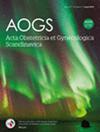Prevalence of cesarean scar disorder in patients 3 years after a first cesarean section
Abstract
Introduction
A symptomatic uterine niche is a long-term complication after a cesarean section (CS). A group of international niche experts reached consensus on a standardized definition of a disorder caused by a symptomatic niche, named cesarean scar disorder (CSDi). However, the prevalence of this disorder is unclear. The aim of this study was to assess the prevalence of CSDi in patients 3 years after a first CS.
Material and Methods
A secondary analysis was performed on the 3-year follow-up results of the 2Close study. The 2Close study was a multicenter randomized controlled trial that evaluated single- versus double-layer uterine closure at CS in 32 hospitals in the Netherlands and included 2292 patients (registered in Dutch trial register: [NTR5480]). Patients, aged ≥18 years, undergoing a first CS were included. Three months after their CS, transvaginal ultrasonography was performed to evaluate the uterine scar for the presence of a niche. Three years after their CS, a digital questionnaire was sent to evaluate the primary and secondary symptoms of CSDi. For this secondary analysis, patients were excluded if they were pregnant, breastfeeding, or using hormonal contraception. The primary outcome of the study was the prevalence of CSDi.
Results
Of the 1648 participants who completed the 3-year questionnaire, patients were excluded due to pregnancy or breastfeeding (n = 305), use of hormonal contraception (n = 509), missing ultrasound evaluations (n = 76), and incomplete responses (n = 88). Of the 670 patients included in this analysis, 543 (81.0%) had a uterine niche visible on ultrasound and 127 (19.0%) were without a niche. The prevalence of CSDi at 3 years following a first CS was 42.5% (285/670). Most reported symptoms were chronic pelvic pain (35.0%), postmenstrual spotting (32.8%), and abnormal vaginal discharge (23.2%).
Conclusions
Our study found a high prevalence of CSDi 3 years following their first CS. Symptoms were self-reported and the exclusion criteria of pregnancy, breastfeeding, or hormonal contraception use could have introduced selection bias. Therefore, this percentage could be an overestimation of the actual prevalence. However, this high prevalence should be included in counseling patients with a scheduled CS.





 求助内容:
求助内容: 应助结果提醒方式:
应助结果提醒方式:


